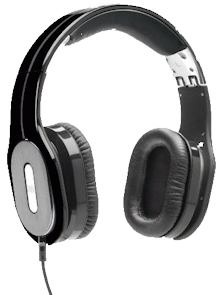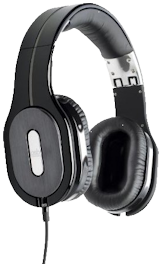Introduction
aka earphones, especially the in-ear type. Headsets, in contrast, include a microphone. For the same dollars, you
can get much higher sound quality with headphones or earphones than with speakers.
With earphones you can block out the noise surrounding you and the sound you are
listening to will not bother others. Some have sound-cancelling logic to filter out
background sound. Some earphones/headphones let you hear background sound. Some seal
it out. You might use earphones on your computer sound output or on your Mp3 player.
The current state of the art is the Sonomax Soundcage. It can be programmed to let
through only certain outside frequencies or volumes.
Testing
Most stores now won’t let you try out headphones or earphones before you
buy. There are several problems with this:
- You can’t judge sound quality.
- You can’t judge comfort/size.
- You can’t judge durability. What might look durable through the packaging
make turn out to be silver painted cheap plastic.
One way around this is to buy only products you have tried out belonging to a
friend. You can also check out reviews from as many different sources as
possible.
Impedance
Headphones for phones, laptops and PCs are under 50
Ω. High end headphones for stereo systems may be 250 or even 600 Ω which require a headphone amplifier.
Your PC does not care the impedance for a USB (Universal Serial Bus) headphone/headset.
Tips
- If you are watching an online streaming movie and the sound keeps breaking up
or generally bad quality, even though it is digital, the problem is the packets are
not coming fast enough and the software is filling in a little bark wherever the
data for the sound are missing or late. You can try reducing the size of the
picture, to reduce the total number of packets per second that have to squeeze
through your Internet connection. You can also see if there a way to download the
video, or fetch it from DVD (Digital Video Disc) and watch it later offline.
- Find a program or test that will make some sound in the left ear, then the
right, then both. This quickly lets you ensure your headset/headphone hardware is
working. Make a note of where you found the software.
- There are converter plugs you can buy separately that let you use a traditional headphone jack in a USB port.
Connectors
For digital-noise-free quality, you use USB connectors. They can produce 6.1 or 7.1 or in theory
any number of channels. The sound ports that come with the motherboard typically offer a connector for a 3.5 mm stereo jack.
Apple products such as iPod, iPad, iPhone all use the 3.5 mm stereo jack too. Eventually, Apple may offer proprietary digital sound headphones using
its lightning connector.
The Ideal
I would like a product like this, designed for home office use, which I have not
seen advertised:
- Wireless headset with durable comfy over-the-head noise-cancelling earphones
and integrated directional microphone.
- Ability to temporarily turn off the noise cancelling feature when you need to
monitor room noise.
- Connects simultaneously to your USB
computer port, Stereo S/PDIF (Sony/Philips Digital Interconnect Format) port and telephone jack. It merges the sound from
all three.
- A computer application lets control the mixing and auto-muting, e.g. default
stereo shuts off when computer makes a noise and computer sound shuts off when a
phone call is in progress.
- It is a software phone, with a conventional POTS (Plain Old Telephone Service)
connection, not VOIP (Voice Over Internet Protocol). You do
your dialing with a computer app. You can answer the phone or hang up with a
button on the headset and wander around talking.
- You can take computer dictation wandering around your home.
- It might work with Blue Tooth, WiFi (Wireless Fidelity)
or its own private RF (Republican Fantasy) band. The range should
be a the size of a typical house.
- It would let you take phone calls anywhere in your home.
- It would have the precautions to prevent others from snooping on the
traffic.
- It has a recharging cradle. The cradle has cables to your computer, stereo,
phone jack and AC (Alternating Current) wall
outlet.
- Plantronics makes some devices that make a crude stab at such a device, that
integrate computer and phone, but not stereo. They use custom interfaces to a
a physical telephone using mechanical lifters to answer the phone. That is
too Rube Goldberg to even consider. An interface to the phone jack would be much
simpler, reliable and would give much higher sound quality.
Headphones or Headset?
Advantages of a Headset
- The headset holds the microphone in place right in front of your mouth no matter where you turn your head.
- The headset holds the microphone close to your mouth, which lets the noise canceling logic easily tell your voice apart from background noise.
- USB port will attach to a laptop that does not have the necessary analog jacks.
- USB port is immune to electrical hum emanating from the computer.
Disadvantages of a Headset
- If the microphone breaks off from the headset, you must buy a whole new unit.
Advantages of a Separate Headphone/Microphone
- For the same dollars, you can get better quality equipment.
- If you make a video, you don’t have to look like a geek wearing a headset.
- You can spend your dollars where you need the extra quality, on the microphone or the headphones.
Disadvantages of a Separate Headphone/Microphone
- You must hold your head steady, pointed at and close to the microphone. You can’t turn your head to look at parts of the screen.
- You need some way to mount the microphone close to your mouth.
Shopping for Headphones
$5.58electronic link to Belkin Speaker and Headphone Splitter
 |
recommend electronic⇒Belkin Speaker and Headphone Splitter |
| asin |
B00009WQSR |
|---|
| Let’s you attach two headphones, but not two headsets, simultaneously. 3.5mm. Belkin is a quality brand. When buying a splitter, make sure you get one for desktops/laptops. Make sure it lets you attach to headphones, not one headset to split out the microphone jack. |
|
| Greyed out stores probably do not have the item in stock |
$49.89electronic link to Bedphones Gen. 3 On-Ear Sleep Headphones - Blue
 |
recommend electronic⇒Bedphones Gen. 3 On-Ear Sleep Headphones - Blue |
| asin |
B017GLFG2C |
|---|
| Earphones are padded, reinforced and thin to make them suitable for use when sleeping. Come in black or blue. You wear one pressed against each ear. Plug: standard 3.5mm stereo, gold-plated. Frequency Range: 20 — 20kHz. (not particularly impressive.) I bought some for my roommate. She said that even with the padding, the earphones were too hard to sleep on. Further she said the earphones would not stay in position. They work for casual use, but not for sleeping. FAQ |
|
| Greyed out stores probably do not have the item in stock |
$58.56electronic link to JVC HARX900 full size Stereo Earphones
 |
recommend electronic⇒JVC HARX900 full size Stereo Earphones |
| asin |
B0013P3ZOE |
|---|
| non-USB headphone. No microphone. Full size. Big pillowy padding. Specs. |
|
| Greyed out stores probably do not have the item in stock |
$69.95electronic link to Sennheiser HD215 Headphone
 |
recommend electronic⇒Sennheiser HD215 Headphone |
| asin |
B003LPTB4M |
|---|
| There is some confusion if this is called a HD215 or and HD215II. The HD215 may be an older version. Closed. 12 — 22000 Hz. Reviews suggest this is comfortable and durable. I concur, it is comfortable, however, the band that goes over your head is made of plastic. That suggests it will break easily. However, the foam will start to flake off after the first year. You can buy replacement ear pads. It is not USB. It comes with two sizes of jack (one screwed inside the other) so you can use it on your computer or your stereo. DJ class. It strongly cuts out room noise. You insert it in the lime green socket on your PC, and, in the control panel, configure your PC to use speakers, not headphones. It does not have a volume control on the cord. You use your stereo or PC volume controls. It has a long stretchy coiled cord. It does not get fouled around furniture the way an uncoiled cord does. This is what I have myself. I am quite pleased with it. About the only negative is it feels clammy after extended use. It was my second choice after the Beyerdynamic MMX 2 which has been discontinued. specs. |
|
| Greyed out stores probably do not have the item in stock |
$189.99electronic link to Harmon AKG Q 701 Quincy Jones Signature Reference-Class Premium Headphones
 |
recommend electronic⇒Harmon AKG Q 701 Quincy Jones Signature Reference-Class Premium Headphones |
| asin |
B004444O46 |
|---|
| non-USB headphone. No microphone. Lime with black accents. Three different gold-plated tips. Made in Austria. 10Hz to 39.8kHz. |
|
| Greyed out stores probably do not have the item in stock |
$190.00electronic link to Bose QuietComfort 15 Headphones
 |
recommend electronic⇒Bose QuietComfort 15 Headphones |
| asin |
B0054JJ0QW |
|---|
| Non-USB. Noise cancelling. Designed primarily to hook up to a stereo. Has a connector for use in airplanes. Use battery that lasts 35 hours. They use conventional cables. Goes around the ear. The Model 3 is on-ear. Bose does not divulge the specifications. They expect you to trust they will be good just because of the brand name. details. Wirecutter.com say they do the best noise cancelling. |
|
| Greyed out stores probably do not have the item in stock |
$198.00electronic link to Sony h.ear on Premium Hi-Res Stereo Headphones, Lime Yellow.
 |
recommend electronic⇒Sony h.ear on Premium Hi-Res Stereo Headphones, Lime Yellow. |
| asin |
B015ZDH4EQ |
|---|
| Also come in Viridian Blue, Charcoal Black, Bordeaux Pink and Cinnabar Red. Solid vibrant colours, not just accents. Not USB. Connector: L-shaped gold-plated 4-pole mini plug. I don’t know anything that uses this format of plug directly. You would think you would need some sort of adapter to convert it into 3-pole plug that the PC uses, but some say it will work directly. 5—60,000 Hz. specs. |
|
| Greyed out stores probably do not have the item in stock |
$239.99electronic link to PSB M4U 1 High Performance Over-Ear Headphones
 |
recommend electronic⇒PSB M4U 1 High Performance Over-Ear Headphones |
| asin |
B00AFUE7S6 |
|---|
| No noise suppression. Top rated by Wirecutter.com. Comes in white, red, grey and black. No USB connection. Specs. |
|
| Greyed out stores probably do not have the item in stock |
$289.95electronic link to Sennheiser RS 180 Digital Wireless Headphone System
 |
recommend electronic⇒Sennheiser RS 180 Digital Wireless Headphone System |
| asin |
B002TLT10S |
|---|
 |
| Includes charging station. Non-USB. specs. |
|
| Greyed out stores probably do not have the item in stock |
$299.00electronic link to PSB M4U 2 Active Noise-Cancelling Headphones
 |
recommend electronic⇒PSB M4U 2 Active Noise-Cancelling Headphones |
| asin |
B007TTD7VO |
|---|
| With noise suppression. No USB connection. Top rated by Wirecutter.com. Comes in white, red, grey and black. Specs. |
|
| Greyed out stores probably do not have the item in stock |
$1,077.02electronic link to Beyerdynamic T1 2nd Generation Audiophile Stereo Headphones with Dynamic Semi-Open Design (Silver)
 |
recommend electronic⇒Beyerdynamic T1 2nd Generation Audiophile Stereo Headphones with Dynamic Semi-Open Design (Silver) |
| asin |
B015ACX03G |
|---|
| 600 Ω Make sure your stereo is capable of driving it. Over the ear. Noise isolation. |
|
| Greyed out stores probably do not have the item in stock |
 headphones
headphones











